There are nearly 200 species of animals that answer to the name monkey. Each one has phenotypic and genotypic differences that divide them into into breeds and species.
Monkeys come in all shapes, colors, and sizes and can be quite funny and adorable in appearance.
This article will focus on 17 of the cutest small monkey breeds.
We will focus on their origins, conservation status, a few facts about them, and their suitability as pets.
Table of Contents
Tarsiers
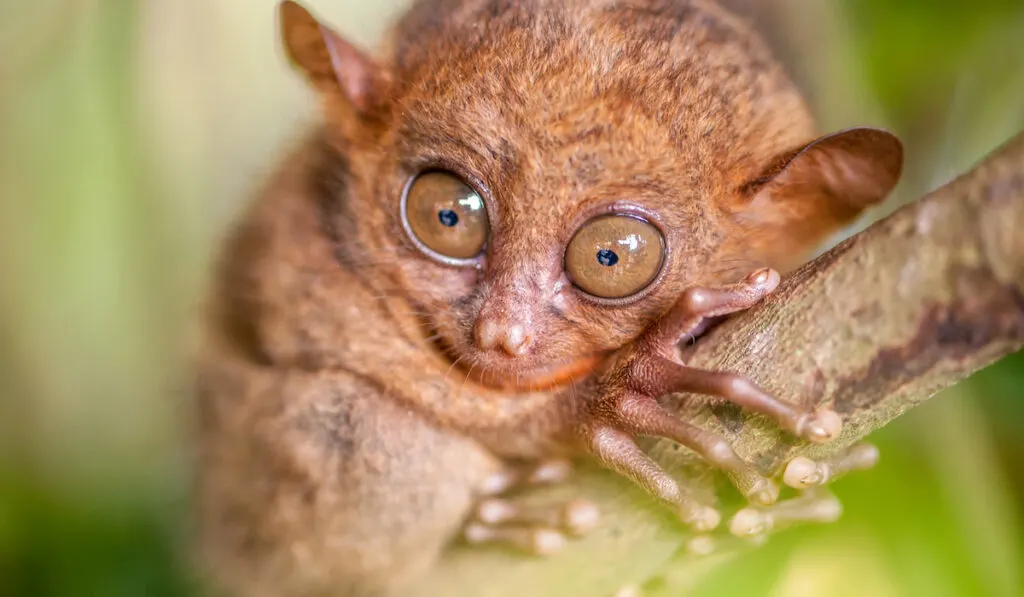
Tarsiers are small Southeast Asian monkeys, and they can be found on various Islands within the region.
This group of tiny monkeys is intermediate between lemurs and larger monkeys. Like lemurs, they are nocturnal with a heightened sense of smell.
On the other hand, they have dry, hair-covered noses like apes, larger monkeys, and humans.
Tarsiers have long tails; their tails are around 2 times the length of their bodies.
Adult Tarsiers measure between 4 and 6 inches without their tail. With it, they measure 12-18 inches.
One unique and famed feature of Tarsiers is their eyes. They have intense big cute yellow eyes that are wide open. It’s hard to miss this feature.
Tarsiers are currently listed as vulnerable to extinction, threatened, endangered, or critically endangered.
Common Marmosets
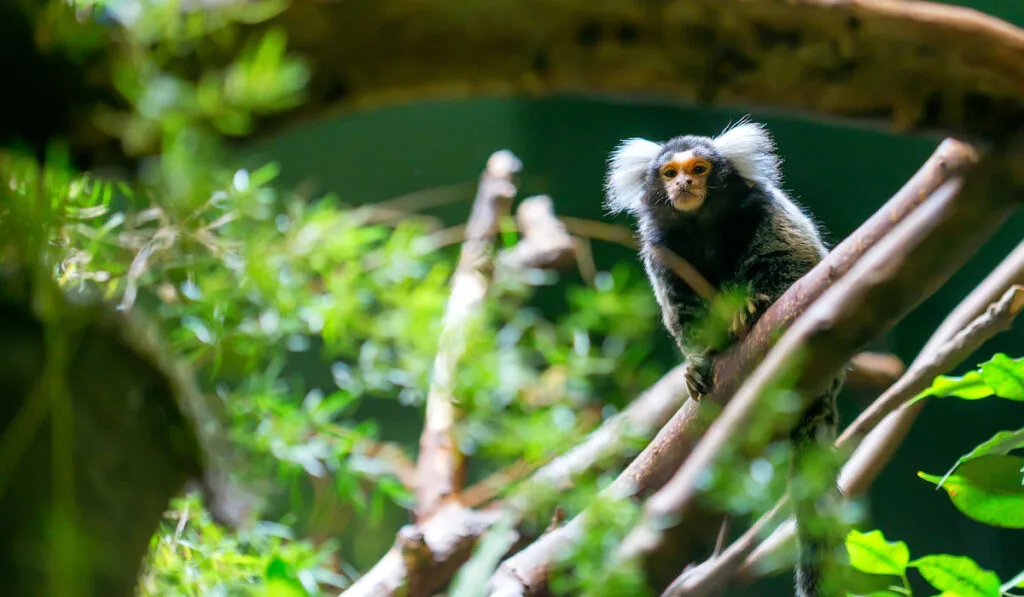
Common Marmosets are a stable population of small monkeys. They are New World monkeys that originated from South America, particularly Brazil.
They typically grow as long as 5-8 inches (excluding their tail) with a mass of between 0.6-1 pound.
Common Marmosets currently have a stable population. They move in groups of 8-10, and the group has a breeding pair that also leads them.
Night Monkeys
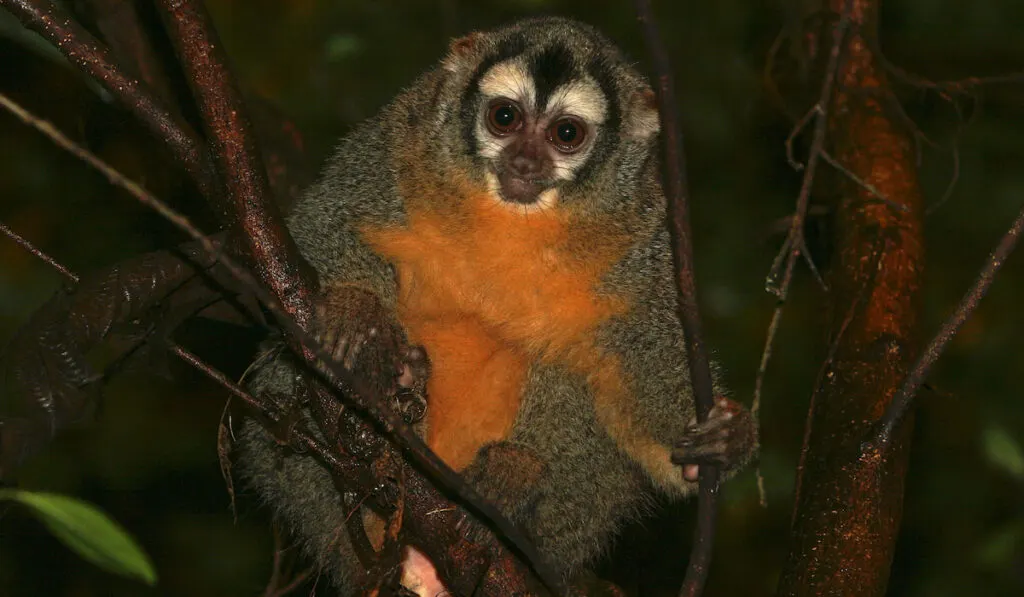
Night monkeys are also called Owl monkeys, and they belong to the New World monkey class.
Night monkeys originated from Panama and various other regions of South America.
Night monkeys are nocturnal and are perhaps the only true nocturnal monkey. They grow as heavy as 1-2.8 pounds and as long as 13.5-25 inches.
The conservation status this species varies a bit. While the Peruvian Night monkey is endangered, 4 species are least-concern, 4 others are vulnerable, and there is insufficient data on 2 species.
Titi Monkeys
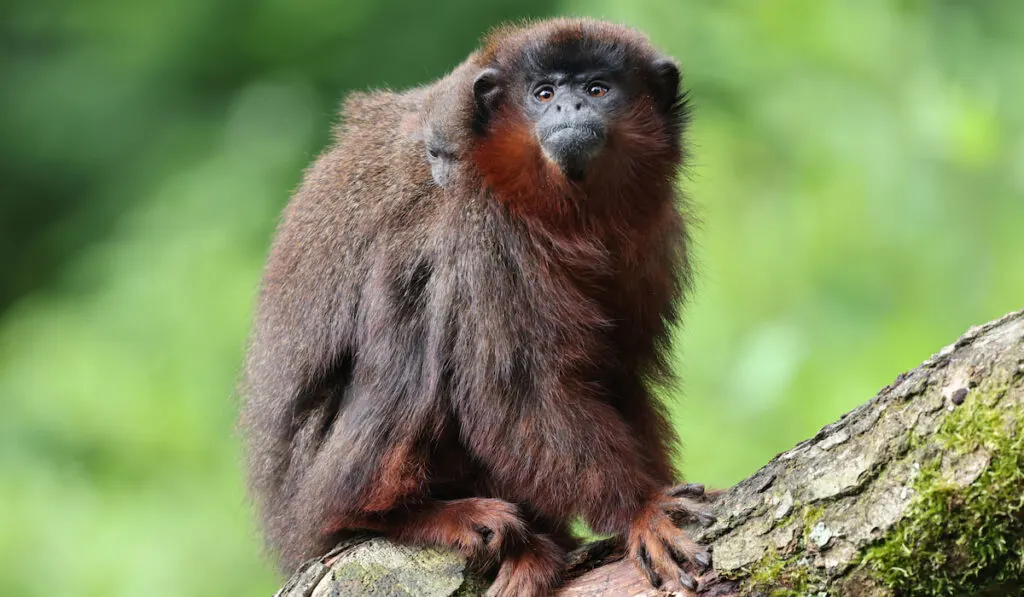
Titi monkeys are New World monkeys from the Amazon River Basin in Brazil.
They commonly live in swamps and forests in lower tree canopies along lake and river shores.
Titi monkeys grow as long as 13 inches without their tail. The tail on its own is about a third or fourth of their body length.
They have an average weight of 2.2 pounds, and their conservation status is currently listed as least concern.
Pygmy Marmosets
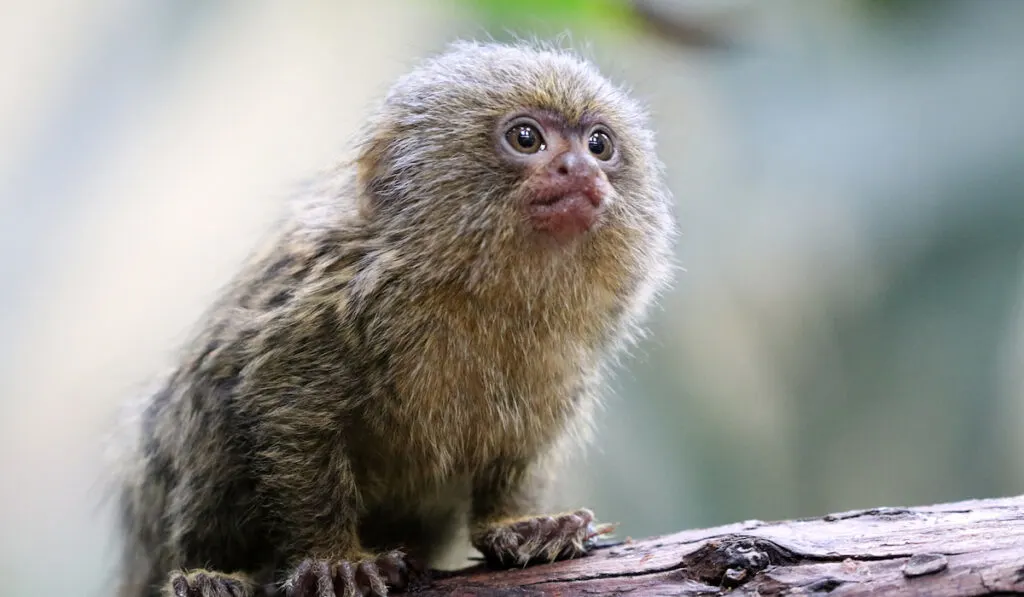
Pygmy Marmosets are also New World monkeys.
They originated in the rain forest canopy of South America and are commonly found in the Amazon regions of Ecuador, Brazil, Peru, Colombia, and northern Bolivia.
Alongside Tarsiers, Pygmy Marmosets are the smallest monkeys in the world. Some full-grown adults of this breed can even fit in a human adult’s hand.
On average, they measure 5-6 inches in length without their tail. In some cases, people even call them finger monkeys.
Pygmy Marmosets are threatened by pet trade and habitat destruction. However, they are listed as least concern but have a decreasing population.
Howler Monkeys
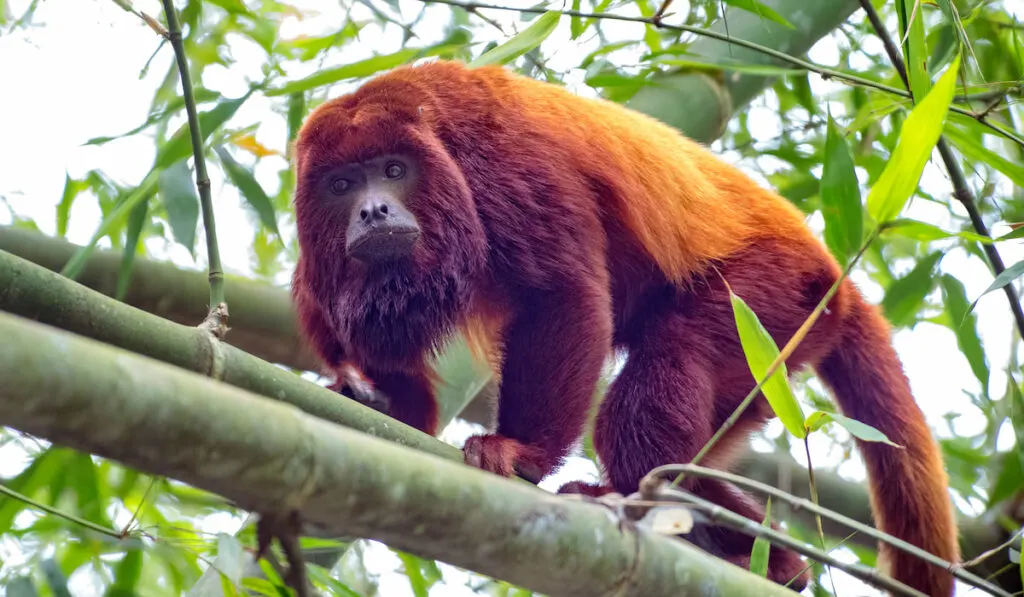
Howler monkeys are on the larger end of the small monkey breed spectrum, weighing an average of 15-22 pounds. They are New World Monkeys with origins in Central and South America.
On average, they grow as tall as 22-36 inches, excluding their tail. The tail of a Howler monkey is about the same size as its body. This breed of monkeys has a tail they can use as an extra arm.
Howler monkeys are so named because of their unique cries; one can hear them make this sound up to 3 miles away.
The most common species of Howler monkey is the Red Howler.
This species is currently of least concern. But the Black-and-Gold Howler is near threatened, and Northern Brown Howler is critically endangered.
The Conservation Status of other Howler monkeys varies similarly.
White-Faced Saki Monkeys
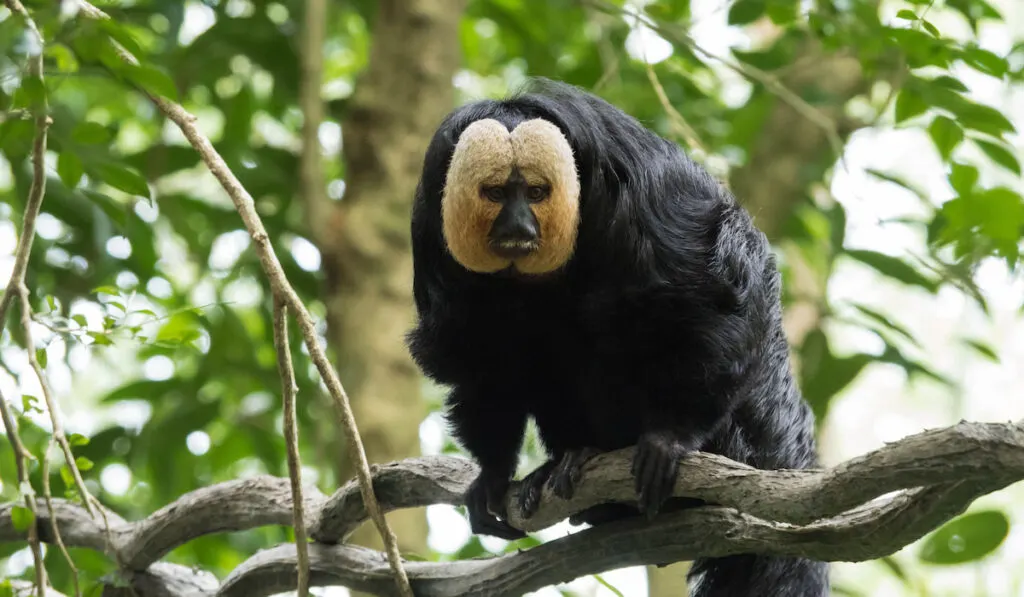
You may expect that White-Faced Saki monkeys have white faces. But only the males have white fur on their faces.
White-Faced Sakis are indigenous to northeastern South America.
This breed of monkeys is found in places like Guyana, northern Brazil, Venezuela, Suriname, and French Guiana.
White-Faced Sakis typically grow 12.5-16 inches, and their tails are almost the same length as their bodies.
They weigh an average of 0.8-5.3 pounds with the males weighing more than the females.
The population of White-Faced Sakis is stable. The International Union for Conservation of Nature (IUCN) lists them as least concern.
Squirrel Monkeys
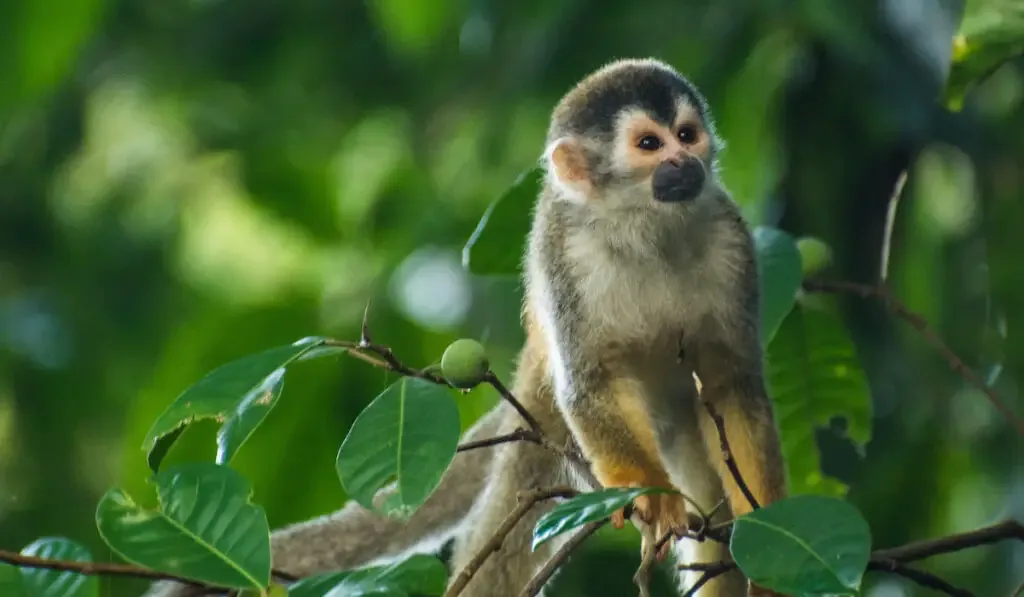
Squirrel monkeys are also New World monkeys, but they do not have a prehensile tail. Their tail mainly functions for balance.
This breed of small monkeys is commonly found in Central American and South American tropical rain forest. They live in the canopy layer within this region.
Squirrel monkeys are diurnal. They are quite vocal, with up to 30 different types of calls.
Adult members of this breed of monkeys grow as long as 12.5 inches. Their tail, on the other hand, grows as long as 16 inches.
According to the IUCN, the population of Squirrel Monkeys is listed as least concern. They live for up to 25 years.
One odd thing you might see Squirrel Monkeys do is pee on their hand. This act is a way for them to mark their territory.
They also do this to clean themselves and to control their body temperature.
Spider Monkeys
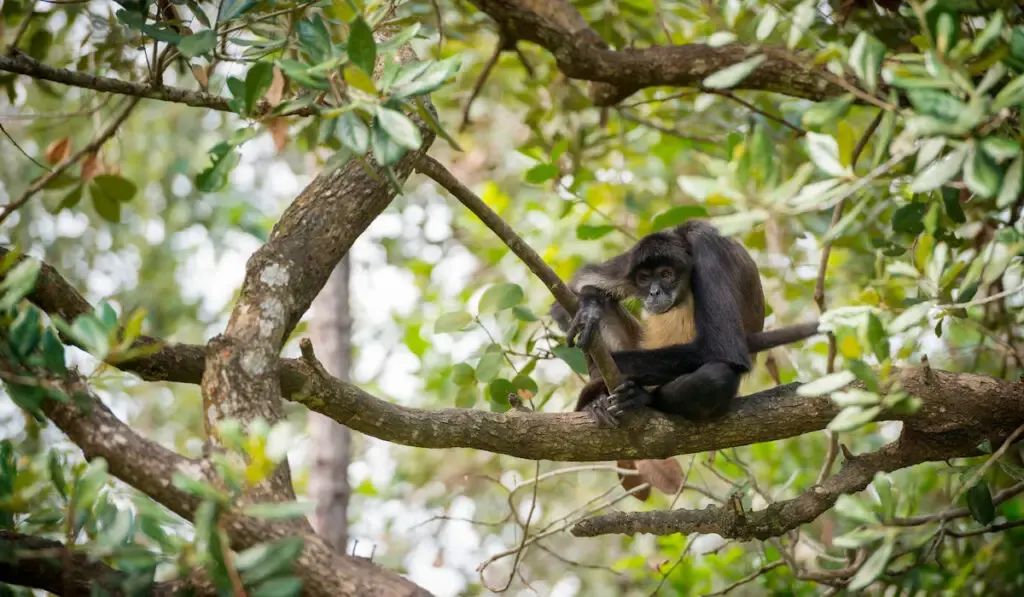
Spider monkeys inhabit forests in Central America, South America, and Southern Mexico.
Spider monkeys have thumbless hands but move from tree to tree swiftly, with their prehensile tail.
Adult Spider monkeys typically have a body length of 14-26 inches and an average weight of 13 pounds.
They live in bands containing about 35 members but move in smaller groups when searching for food.
The IUCN lists all Spider monkeys as threatened. Their population is reported to be affected mainly by hunting pressure and loss of habitat.
Note that the Woolly Spider monkey, although closely related to the Spider monkeys, is not a true monkey. It also belongs to a different genus – Brachyteles.
Macaques
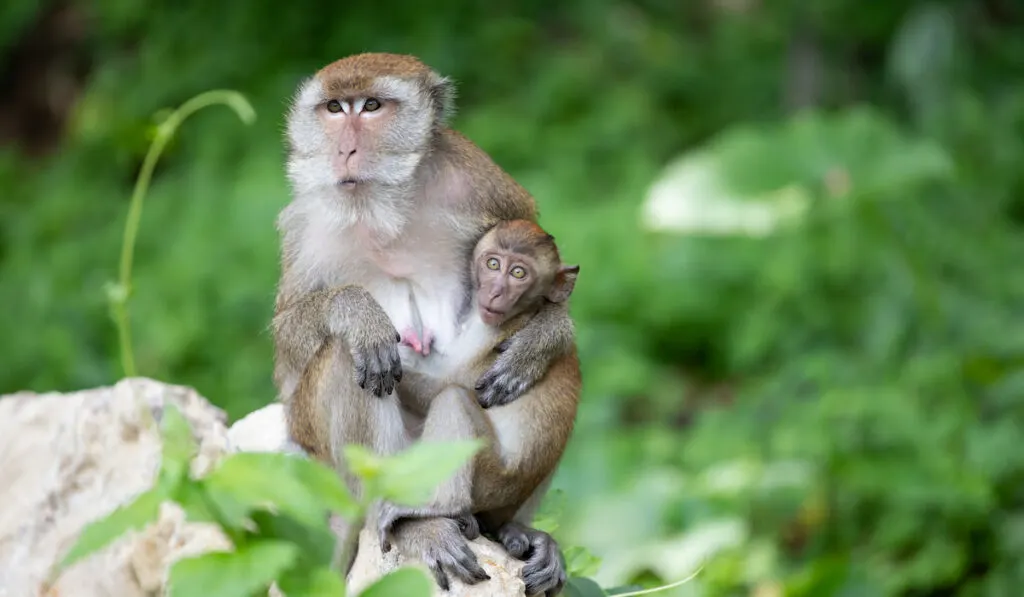
Unlike most other breeds on this list, Macaques are Old World monkeys.
This means they do not have prehensile tails, and their noses are narrow with a thin septum.
Macaques are a breed containing over 20 species. Most have Asian origins, while one, Barbary Macaque, is from North Africa.
Macaques have a body length of 16-28 inches. The females grow to be as heavy as 5-28 pounds while the males weigh 12-40 pounds.
The species of this breed have long been used in various medical research, especially Rhesus monkeys and Crab-Eating monkeys.
The conservation status of Macaques varies across species. Barbary Macaques are endangered, Rhesus Macaques are listed as least concern, and Crab-Eating Macaques are vulnerable.
Gibbons
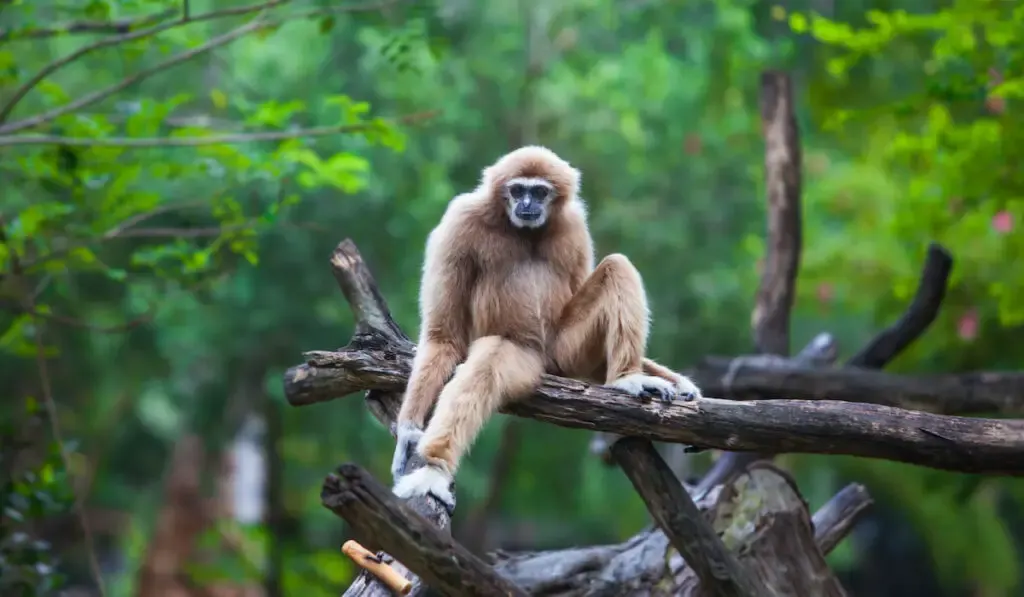
Gibbons are very acrobatic animals. They are commonly found in Southern Asian forests where they spend most of their time in trees of dense forests.
Gibbons have a unique type of movement called brachiating. This movement allows them to move as fast as 35 mph. They can also cover gaps of up to 50 feet with just one leap.
Brachiating also makes it easy for them to swing and pick fruits growing at the end of branches.
The consequence of this ability is that they do not have to compete too much for their favorite foods.
Another unique thing about Gibbons is their bipedal movement.
Gibbons are the closest to humans when it comes to bipedal abilities. In fact, they are commonly studied to determine the evolutionary pressure that pushed humans to be bipedal.
On average, Adults of this breed have a body length of 17-25 inches and weigh 11-28 pounds.
Gibbons live for up to 25 years. They have loud, music-like voices that reach long distances.
The Eastern Hoolock Gibbon is listed as vulnerable. Black Crested Gibbon, Hainan Gibbon, Northern White-Cheeked Gibbon, and Cao-Vit Gibbon are critically endangered.
In fact, the Hainan Gibbon is considered the most endangered primate in the world. Besides these 5 species, 13 other species of Gibbons are listed as endangered.
Guenons
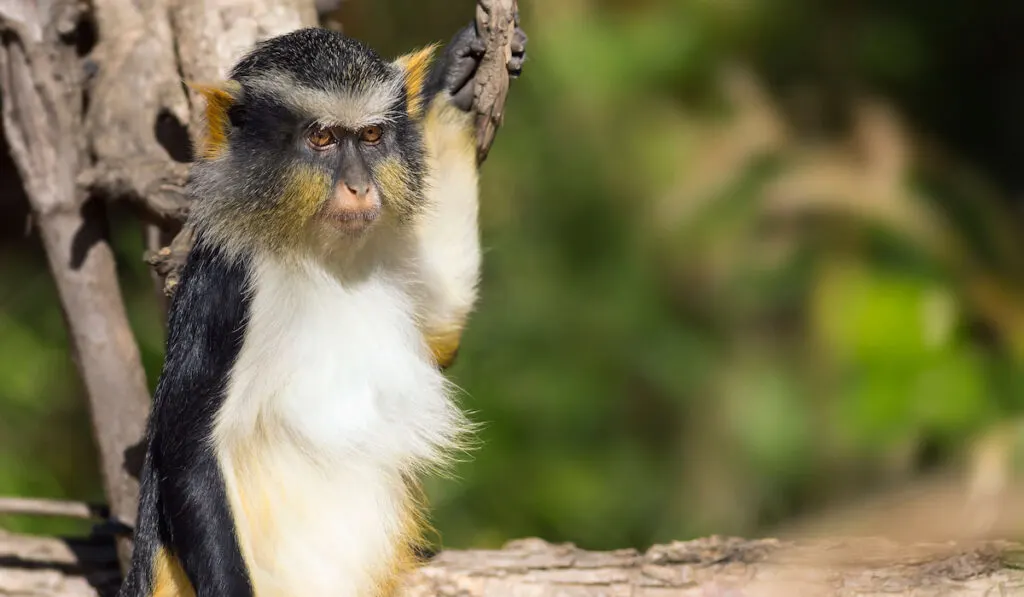
Guenons are Old World monkeys. Guenons originated from Central Africa and West Africa.
They typically live in groups comprising mostly of females and at least one male.
They have narrow noses pointing downwards, with a thin septum. Guenons have long tails for balance, round heads, and long hind legs.
Guenons have an average weight of 2.2-28 pounds and a body length of 10-34 inches. They have an average lifespan of 16 years.
Most species of Guenons are near threatened. They are exposed to habitat loss and significant levels of hunting.
Capuchin Monkeys
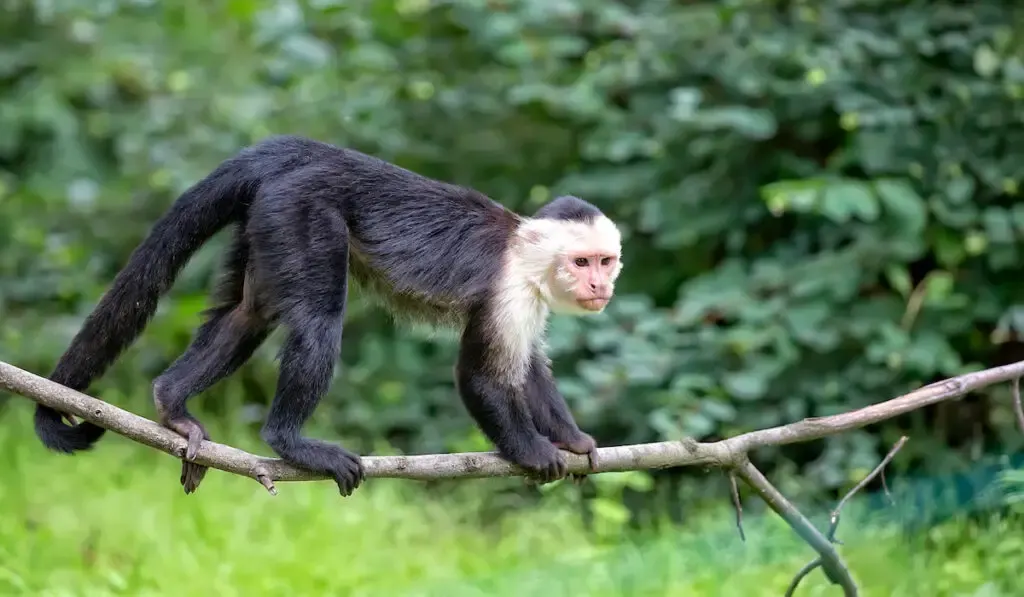
Capuchin monkeys are native to Central and South America.
They are revered for their intelligence and are even considered one of the most intelligent New World monkeys.
Capuchin monkeys, also known as sapajou, grow to lengths of 12-22 inches. They have prehensile tails and opposable thumbs.
Capuchin monkeys come with black or dark brown fur. Some species have white fur on their face and around their upper chest.
This small monkey breed is found usually atop tall forest trees. But they also shuffle between the forest floor and trees.
Capuchin Monkeys usually move in noisy troops comprising young monkeys and adults.
Capuchin Monkeys give birth any time of the year, and in the dry season, the Central American births are higher.
Golden-Bellied Capuchins and Ecuadorian White-Fronted Capuchins are critically endangered. Guianan Weeper Capuchin, Large-Headed Capuchin, and Tufted Capuchin are listed as least concern.
Blond Capuchin is endangered, Bearded Capuchin is near threatened, and White-Throated Capuchin is vulnerable.
Golden Lion Tamarins
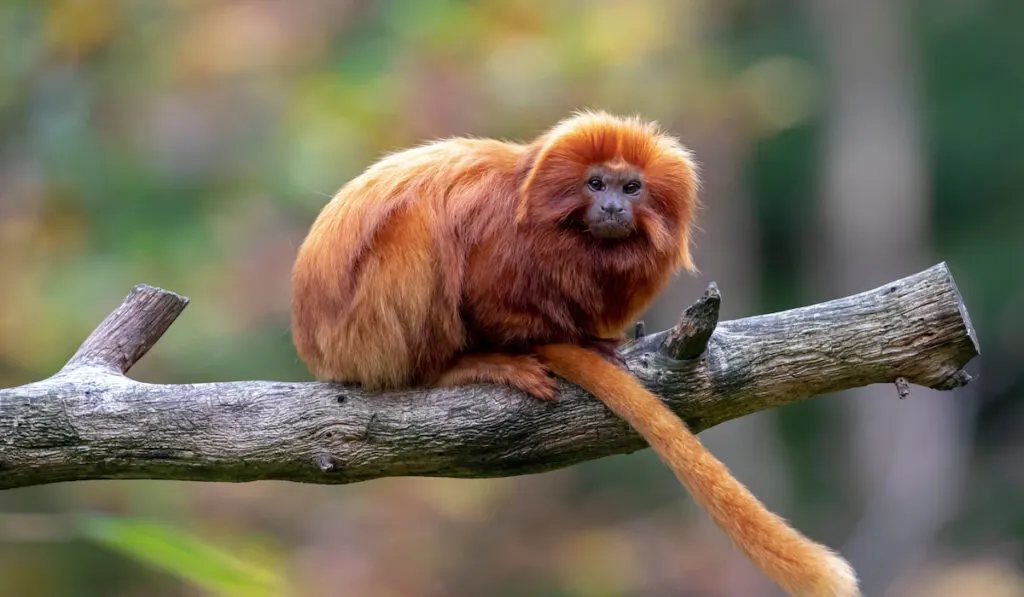
The Golden Lion Tamarin is a breed from the Brazilian Atlantic coastal forests.
They are small New World monkeys that have an appearance similar to that of a lion with a reddish mane and fur.
Golden Lion Tamarins have social family groups, with each one having a breed pair.
Female Golden Lion Tamarin usually birth twins. The males take part in raising the babies, and sometimes, they even carry them on their backs.
They are territorial and defensive. A Golden Lion Tamarin marks its turf with scent markings and defends it with vocal threats.
They also arch their backs, open their mouths, or stare to show aggression.
Adult Golden Lion Tamarins typically weigh 0.8-1.5 pounds with body lengths measuring 6-15 inches.
Golden Lion Tamarins are endangered, but they currently have a stable population. They are threatened by loss of habitat due to logging and industrialization.
Vervet Monkeys
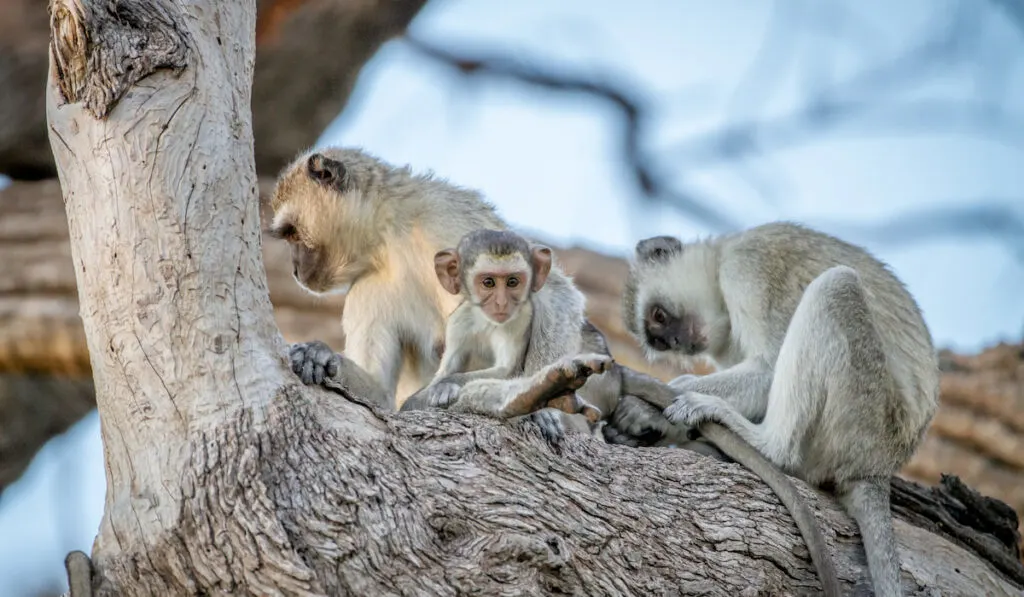
Vervet monkeys are agile Old World monkeys native to East Africa.
They move in troops of up to 50 members, with a stable social structure. They typically live in savannas, woodlands, and high bushes.
Vervey monkeys have grey or olive-green fur. Their hands, ears, feet, faces, and the tip of their tail are covered in black fur, and their forehead has a visible white band.
Male Vervet monkeys, which are larger than the females, can readily be spotted with their red penis and blue scrotum.
Adult Vervet monkeys weigh 6.6-11 pounds and measure 15-24 inches in body length. Their tails are almost as long as their body as they measure 11-20 inches.
A 2016 assessment by IUCN Red List lists Vervet monkey as least concern. That aside, they are threatened by hunting pressure and persecution.
Red-Handed Tamarins
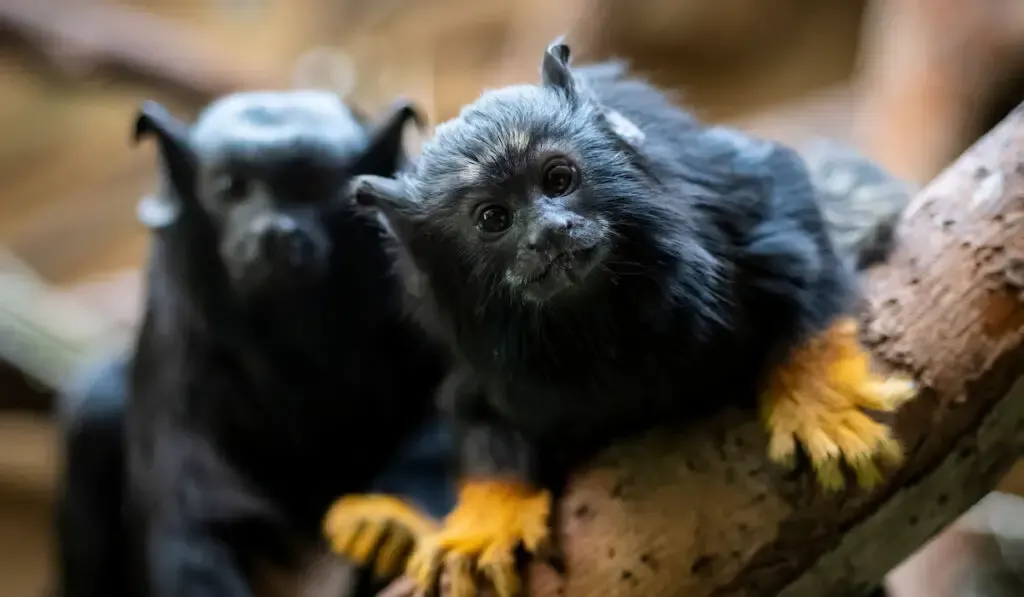
Red-Handed Tamarins are also called Midas Tamarins and Golden-Handed Tamarins because of the red hair on their limbs.
Red-Handed Tamarins originate from rainforests in the northern Amazon River. You’ll find them in countries such as Brazil, Surinam, Guyana, and French Guiana.
Red-Handed Tamarins are arboreal and can jump as high as 60 feet from the forest floor.
They move in mixed groups of 4-15 members predominated by males. Red-Handed Tamarins are led by the oldest female in the group.
On average, Red-Handed Tamarins have a body length of 7-12 inches and a body mass of 0.8-1.1 pounds.
These monkeys have predominantly black fur, opposable thumbs, and red hair on their feet and hands.
While Red-Handed Tamarins are listed as least concern by IUCN, loss of habitat poses a threat to them.
They are also prey to many predators including humans, dogs, snakes, and birds of prey.
Green Monkeys
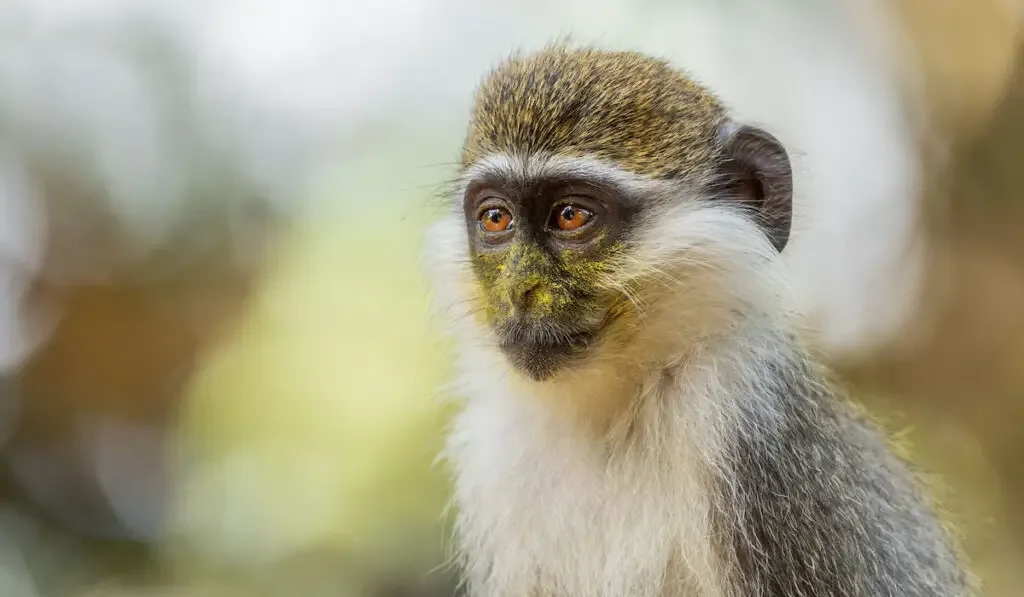
The Green monkey is native to West Africa. It is an Old World monkey breed that belongs to the same genus as Vervet monkey.
They live in transitional forests and other habitats, including savannas and mangrove swamps.
Green monkeys usually avoid places with dense, wet forests.
Members of this species have green-tinted golden fur. Their faces are hairless, and they have long, semi-prehensile tails.
On average, Green monkeys reach body lengths of 12-19 inches, and they weigh an average of 7.7-17 pounds.
Green monkeys are polygynous; they breed between April and June every year, and each birth typically leads to one offspring.
This species is social; they move in troops of 7-80 members.
In each troop, there’s a significant show of dominance by alpha males. These types establish their dominance through scrotal displays and fighting.
They also limit the contact of other males to females in their territory. Alpha male Green monkeys are expectedly aggressive toward alien males.
IUCN is listed as least concern. But trapping, loss of habitat, and hunting are still threats to the stability of their population.
Comparing the Cutest Small Monkey Breeds
| Species | Adult Size (Body length excluding tail) | Origin | Can It Be a Pet? |
| Tarsier | Length: 4-6 inches | Southeast Asia (Philippines, Brunei, Malaysia, and Indonesia) | No |
| Common Marmoset | Length: 5-8 inches Weight: 0.6-1 pound | Brazil | Yes |
| Night Monkey | Length: 13.5-25 inches Weight: 1-2.8 pounds | Panama | No |
| Titi Monkey | Length: 13 inches Weight: 2.2 pounds | Brazil | No |
| Pygmy Marmoset | Length: 4-6 inches | South America Amazon Regions | Yes |
| Howler Monkey | Length: 22-36 inches Weight: 15-22 pounds | Central and South America | No |
| White-Faced Saki | Length: 12.5-16 inches Weight: 0.8-5.3 pounds | Northeastern South America | No |
| Squirrel Monkey | Length: 10-14 inches | Central and South America | Yes |
| Spider Monkey | Length: 14-26 inches Weight: 13 pounds | Central America, South America, and Southern Mexico | No |
| Macaques | Length: 16-28 inches Weight: 5-40 pounds | Asia and North Africa | Yes |
| Gibbons | Length: 17-25 inches Weight: 11-28 pounds | Southern Asia | No |
| Guenons | Length: 10-34 inches Weight: 2.2-28 pounds | Central and Western Africa | Yes |
| Capuchin Monkey | Length: 12-22 inches | Central and South America | Yes |
| Golden Lion Tamarin | Length: 6-15 inches Weight: 0.8-1.5 pounds | Brazilian Atlantic coastal forests | No |
| Vervet Monkey | Length: 15-24 inches Weight: 6.6-11 pounds | East Africa | No |
| Red-Handed Tamarin | Length: 7-12 inches Weight: 0.8-1.1 pounds | Rainforests around the northern Amazon River | No |
| Green Monkey | Length: 12-19 inches Weight: 7.7-17 pounds | West Africa | No |
Resources
- https://animalhow.com/13-small-monkeys-with-big-cute-eyes-some-can-be-pets/#Tarsiers
- https://doi.org/10.1007%2Fs10764-010-9459-6
- https://www.endangeredspeciesinternational.org/tarsiersection.html
- https://www.britannica.com/animal/tarsier
- https://www.worldlandtrust.org/species/mammals/common-marmoset/
- https://nationalzoo.si.edu/animals/titi-monkey
- https://animals.sandiegozoo.org/animals/pygmy-marmoset
- https://www.nationalgeographic.com/animals/mammals/group/howler-monkeys/
- https://www.neprimateconservancy.org/howler-monkeys.html
- https://www.neprimateconservancy.org/white-faced-saki.html
- https://www.folly-farm.co.uk/zoo/meet-the-zoo-animals/common-squirrel-monkey/
- https://animaldiversity.org/accounts/Saimiri_sciureus/#
- https://www.britannica.com/animal/spider-monkey
- https://www.britannica.com/animal/macaque
- https://www.nationalgeographic.com/animals/mammals/group/gibbons/
- https://www.britannica.com/animal/gibbon-primate
- https://www.gibbonssp.org/conservation-status-1
- https://animals.sandiegozoo.org/animals/guenon
- https://www.neprimateconservancy.org/guenons.html
- https://link.springer.com/chapter/10.1007/0-306-48417-X_26
- https://www.britannica.com/animal/capuchin-monkey
- https://www.neprimateconservancy.org/capuchin-monkeys.html
- https://www.nationalgeographic.com/animals/mammals/g/golden-lion-tamarin/
- https://nationalzoo.si.edu/animals/golden-lion-tamarin
- https://www.awf.org/wildlife-conservation/vervet-monkey
- https://animals.sandiegozoo.org/animals/vervet-monkey
- https://www.iucnredlist.org/species/136271/17957823
- https://ielc.libguides.com/sdzg/factsheets/vervet/population
- https://animaldiversity.org/accounts/Chlorocebus_sabaeus/
- https://www.neprimateconservancy.org/red-handed-tamarin.html
